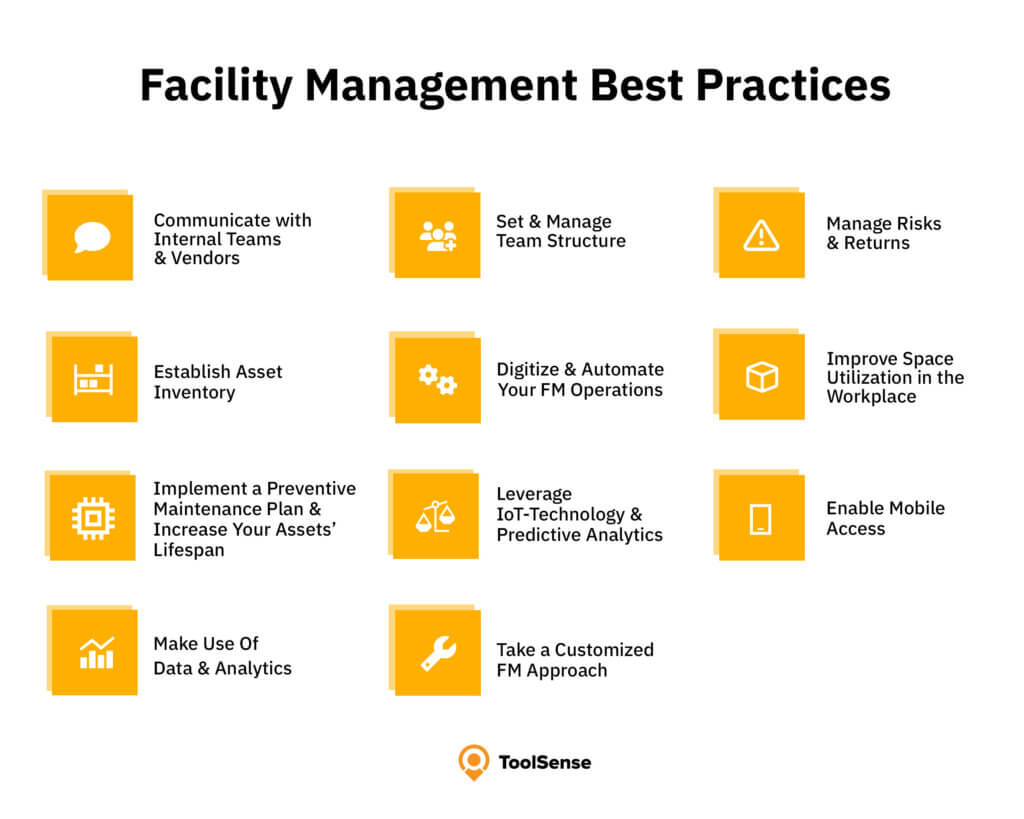Comprehensive Guide to Facility Management for Businesses
Wiki Article
Secret Fads Forming the Future of Center Monitoring in 2024
As we look ahead to 2024, the landscape of center monitoring is positioned for substantial improvement, driven by several key trends. The assimilation of clever building innovations and a change towards data-driven decision-making pledge to boost functional efficiency while prioritizing sustainability in practice.Smart Structure Technologies

Smart building innovations include a vast variety of systems, consisting of smart lights, heating and cooling controls, and safety and security systems. By incorporating these systems, facility supervisors can keep track of and change parameters in real-time, leading to considerable reductions in power waste and functional expenses. Clever sensing units can discover tenancy levels and adjust lighting and temperature appropriately, guaranteeing that energy is only used when necessary.
Additionally, these technologies promote boosted information collection, permitting organizations to track use patterns and recognize chances for additional enhancements. The execution of smart structure technologies not just adds to sustainability objectives but also creates healthier workplace that can increase worker productivity and satisfaction.
As we relocate into 2024, the fostering of wise building technologies will likely increase, showing a wider change towards even more intelligent, responsive, and sustainable facility management techniques.
Data-Driven Decision Making
Significantly, organizations are leveraging data-driven decision making to improve center monitoring techniques. By using data analytics, center managers can derive actionable insights that substantially boost functional effectiveness and source allowance. The integration of advanced innovations, such as IoT sensors and real-time tracking systems, enables the collection of large amounts of information on structure efficiency, occupancy prices, and energy intake.This wealth of information enables facility managers to identify trends, predict upkeep requirements, and proactively address concerns before they escalate. As an example, predictive analytics can anticipate tools failures, minimizing downtime and repair service expenses. Furthermore, data visualization tools assist in better communication among stakeholders, guaranteeing that informed choices are made collaboratively.
In addition, data-driven strategies boost tactical planning by making it possible for facility managers to assess the effectiveness of current methods and make educated choices relating to financial investments in technology or infrastructure. As organizations progressively focus on operational excellence, data-driven choice production is poised to become a keystone of effective center monitoring methods in 2024 and beyond. Eventually, the ability to take advantage of information effectively will encourage companies to produce much more reliable, efficient, and durable facilities.
Sustainability and Green Practices
The focus on data-driven choice making normally straightens with the expanding focus on sustainability and green practices within facility administration. As organizations progressively focus on ecological obligation, center supervisors are leveraging analytics to maximize source use, minimize waste, and minimize carbon footprints. This strategic strategy makes it possible for the assimilation of energy-efficient systems, such as LED lighting, wise HVAC controls, and sustainable power sources into facility operations.In addition, the implementation of lasting methods extends beyond energy intake. Facility managers are promoting and embracing environmentally friendly products recycling initiatives to produce a round economic situation within their facilities. This not just improves the environmental account of the company yet additionally fosters a society of sustainability among workers.
Full Report Conformity with environmental regulations is an additional vital element driving the adoption of eco-friendly methods. By using data analytics, facility managers can check conformity metrics and recognize locations for renovation, guaranteeing adherence to global and local sustainability criteria.
Hybrid Job Versions
A significant change in the direction of crossbreed job designs is reshaping the landscape of facility administration in 2024. This standard incorporates in-office and remote work, demanding a reevaluation of room use, source allotment, and employee engagement methods. Organizations are significantly recognizing the relevance of flexible offices that accommodate diverse demands and preferences.Center supervisors need to adjust by applying flexible workplace layouts that sustain joint initiatives while giving locations for concentrated work. This consists of the combination of technology to facilitate seamless communication and collaboration among in-office and remote staff members. Smart structure solutions, equipped with analytics and sensing units, enable real-time surveillance of room usage, enabling companies to maximize their environments successfully.
In addition, crossbreed work designs emphasize the requirement for effective center administration that prioritizes employee experience. In significance, the hybrid job model is reinventing facility monitoring, urging an aggressive method to meet the developing demands of the workforce.
Boosted Occupant Wellness
As companies embrace hybrid job versions, a heightened emphasis on resident health is coming to be indispensable to center management approaches. Facility Management. This shift recognizes that Look At This a healthy and satisfied workforce straight influences performance and retention prices. Center managers are currently focusing on atmospheres that advertise mental and physical health, incorporating elements such as natural lights, biophilic style, and accessible wellness sources

Modern technology plays an important duty in this advancement. Smart building systems can check ecological elements and readjust setups in real-time, making certain optimum comfort levels - Facility Management. Additionally, responses systems, such as occupancy sensing units and employee surveys, allow center supervisors to continuously fine-tune wellness efforts based upon owner demands.

Conclusion
In 2024, the future of center management will be significantly influenced by the assimilation of wise structure innovations and data-driven redirected here decision-making, cultivating enhanced functional effectiveness. These patterns collectively emphasize the advancing landscape of center management in feedback to modern obstacles and chances.Center supervisors are taking on environment-friendly products and promoting recycling initiatives to produce a circular economic climate within their centers.A significant change in the direction of hybrid job models is improving the landscape of center management in 2024.In addition, hybrid job designs highlight the need for reliable facility monitoring that focuses on staff member experience.As organizations embrace hybrid work versions, an enhanced emphasis on passenger health is coming to be important to center administration methods.In 2024, the future of facility monitoring will be dramatically influenced by the combination of smart structure innovations and data-driven decision-making, promoting enhanced operational performance.
Report this wiki page